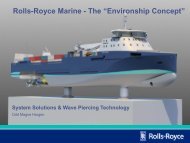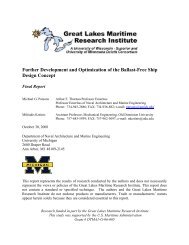15 MB - Great Lakes Maritime Research Institute
15 MB - Great Lakes Maritime Research Institute
15 MB - Great Lakes Maritime Research Institute
Create successful ePaper yourself
Turn your PDF publications into a flip-book with our unique Google optimized e-Paper software.
Relying on the holding in Chevron, courts generally give the regulations promulgated by an agency judicial deference, provided thoseregulations are the result of proper rule-making and reasonable interpret and implement an otherwise ambiguous statutory provision.The Supreme Court in Haggar found that if Congress speaks directly regarding a question, the court must give deference to Congress’specific intent pursuant to Chevron. However, if an agency’s statutory interpretation fills a gap or defines a term, that interpretation isto be given judicial deference, provided the Administrative Procedures Act (5 U.S.C. Section 553) has been complied with.In the case of the regulations in question, Customs had indeed published them in proposed form, accepted comment, and then issuedfinal regulations. In those regulations, permapressing was specifically named as a chemical treatment, which qualified the resultinggarments as having been manufactured, rather than assembled. As a result, the Supreme Court remanded the case to the FederalCircuit for further consideration, as the appellate court had only dealt with the question of Chevron deference and rejected it. Onremand, the Federal Circuit was directed to consider whether the regulations themselves actually warrant deference.The question of Chevron deference was raised again by Customs in Mead Corp. vs. United States, 1999 U.S. App. LEXIS 17831 (Fed. Cir. July 28, 1999). Customs issued a ruling to Mead regarding the tariff provision and rate that would apply to its day-planners.Mead took issue with Customs’ decision. By complying with the requisite procedures, Mead was eventually able to bring the matterbefore the Court of International Trade, which granted Customs’ motion for summary judgment affirming the original classificationdecision.The Federal Circuit took note of the Haggar case and held that a ruling by the Customs Service is an interpretation of a tariffprovision. It does not involve input from any party except the importer to whom the ruling is issued. A ruling is issued only whenrequested by an interested party. It involves no public debate prior to issuance (although it is subject to public comment after the fact ifan appropriate petition to overturn the results is filed - a rare but not unheard of event). A ruling is confined to the specific factspresented. It does not clarify the law or the rights of an importer.Conversely a regulation undergoes notice and comment and provides a mechanism for input from the interested public. It may beamended or changed later in response to subsequent public input. Therefore, the appellate court found that rulings are not entitled toChevron deference. Customs has not yet decided whether it will appeal this decision to the Supreme Court.Many practitioners think the holding in Haggar will force them to carefully monitor each regulation as it is proposed by Customs toensure it is a reasonable interpretation of congressional intent so as to preserve the issue for trial. Many others think it does not meanC-8












